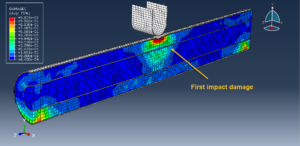In this tutorial, the Investigation on the repeated impact responses of circular concrete-filled double-tube (CFDT) members in Abaqus have been studied. The two concrete cores are modeled as three-dimensional solid parts. The two steel tubes are modeled as three-dimensional solid parts. The rigid hammer as an impact is used also. You can see a figure of the assembled parts below

To meet specific design requirements or achieve superior structural performances, a new type of concrete-filled steel tubular (CFST) composite structure called a concrete-filled double-tube (CFDT) was proposed in recent years. Despite intensive studies on the structural performances of CFDT members under various loading conditions, very limited investigations on the impact responses of CFDT members can be found in the literature. During the service life, structural members may be subjected to extreme loads such as impact load, therefore the investigation of impact responses of CFDT members is essential for impact-resistant design and assessment
To model concrete behavior under impact load, the Concrete Damaged Plasticity model is selected. The model is a continuum, plasticity-based, damage model for concrete. It assumes that the main two failure mechanisms are tensile cracking and compressive crushing of the concrete material. The concrete-damaged plasticity model in Abaqus provides a general capability for modeling concrete and other quasi-brittle materials in all types of structures
To model steel tube behavior, the elastic-plastic model and ductile damage criterion are considered. For both analyses, the dynamic explicit step with a specific time is used. The contact among all surfaces is considered. The proper boundary and mesh are assigned to all parts
After the simulation, all results such as stress, strain, damage, failure, and others are available for both models. The second model contains the results from the first model. You can see some figures for both simulations below








You can provide CAE, INP, and English video files of this simulation here. The cost of these files is Thirty Euros. you can click on the bellow bottom to begin the process
You can purchase the tutorial through a PayPal account, a Visa, or a Master card, just before payment, send me an email to this address: karampourp@gmail.com
 Abaqus tutorials Abaqus tutorials
Abaqus tutorials Abaqus tutorials




